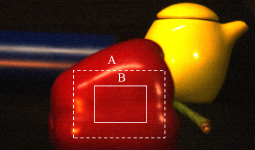
We describe a comprehensive method for estimating the surface-spectral reflectance from the image data of objects acquired under multiple light sources. This study uses the objects made of an inhomogeneous dielectric material with specular highlights. A spectral camera is used as an imaging system. The overall appearance of objects in a scene results from the chromatic factors such as reflectance and illuminant and the shading terms such as surface geometry and position. We first describe the method of estimating the illuminant spectra of multiple light sources based on detecting highlights appearing on object surfaces. The highlight candidates are detected first, and then some appropriate highlight areas are interactively selected among the candidates. Next, we estimate the spectral reflectance from a wide area selected from an object's surface. The color signals observed from the selected area are described using the estimated illuminant spectra, the surfacespectral reflectance, and the shading terms. This estimation utilizes the fact that the definition domains of reflectance and shading terms are different in each other. We develop an iterative algorithm for estimating the reflectance and the shading terms in two steps repeatedly. Finally, the feasibility of the proposed method is confirmed in an experiment using everyday objects under the illumination environment with multiple light sources.